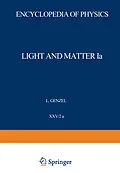159 elements only between states which differ in one of the single-electron wave functions, in short, HeR induces only one-electron transitions. The matrix elements 1mn and Pmn reduce to matrix elements between the single-electron wave functions. We are interested primarily in crystalline solids for which the band model is a good approximation. The Bloch single-electron wave function in this model has the form: N'I ili-';; U. r.;;) ( (1.14) ""nk r, =e nh\r , where n is the band index and U (r) has the periodicity of the lattice. The form of the Bloch function follows from the translational symmetry of the crystal, and the matrix elements between Bloch states are subject to the condition of wave-vector conservation: k'=k, for
Inhalt
Optical Constants and their Measurement.- A. Introduction.- B. Optical properties of an absorbing medium.- I. Maxwell's equations.- II. Characteristics of plane electromagnetic waves.- III. Classification of wave types and modes.- a) Homogeneous and inhomogeneous waves.- b) Transverse electric and transverse magnetic waves.- IV. Intensity of an electromagnetic wave.- V. Reflection and transmission at a plane surface.- a) Character of the reflected and transmitted waves.- b) Amplitude of the reflected and transmitted waves.- c) Special angles for reflection.- VI. Reflection and transmission of a plane, parallel faced plate.- C. Optical properties of simple classical systems.- I. Classical frequency dependence of the conductivity of the free charges.- II. Classical frequency dependence of the dielectric constant of the bound charges.- III. Classical frequency dependence of the optical constants.- a) Resonance circle diagram.- IV. Dispersion relations.- D. Determining optical constants from experimental data.- I. Measurement of the classical model parameters.- II. Specular reflection from a single surface.- a) Graphical constructions for reflectance.- b) Precomputed charts.- c) Special angles of reflectance determination.- d) Dispersion relation calculations.- e) Direct measurement of the phase of the reflectance.- III. Measurements on a lamella.- a) Resolved channeled spectra.- b) Unresolved channeled spectra.- c) Direct measurement of the phase of the transmittance.- IV. Special techniques for optical constant measurements.- a) Measurement of emissivity.- b) Reflectance of an overcoated sample.- c) Attenuated total reflection.- Acknowledgements.- References.- Phonons in Perfect Crystals.- A. Elementary lattice dynamics.- B. Experimental methods.- C. Interpretation of phonon dispersion curves.- D. Calculation of phonon dispersion curves, and comparison with experiment.- E. The frequency distribution of the normal modes.- F. Anharmonic interactions.- G. Lattice dynamics of ferroelectric crystals.- H. Thermodynamic properties.- Appendix: Many-body techniques for anharmonic crystals.- References.- Photon-Electron Interaction, Crystals Without Fields.- A. General theory.- I. Introduction.- II. Dielectric constant of solids.- III. Electron-lattice interaction.- IV. Excitons.- V. Imperfection centers.- B. Experimental observations.- VI. Absorption edge and edge emission.- VII. Free carrier effects in semiconductors.- VIII. Reflection spectra of solids.- IX. Impurity effects.- References.- Magneto-Optics in Crystals.- I. Introduction.- II. Macroscopic theory.- III. Quantum mechanical theory.- IV. Free carrier magneto-optical effects.- a) General theory.- b) The experimental phenomena.- V. Interband effects.- VI. Impurities and magnetic materials.- VII. Experimental techniques.- VIII. Summary.- Sachverzeichnis (Deutsch-Englisch).- Subject Index (English-German).
